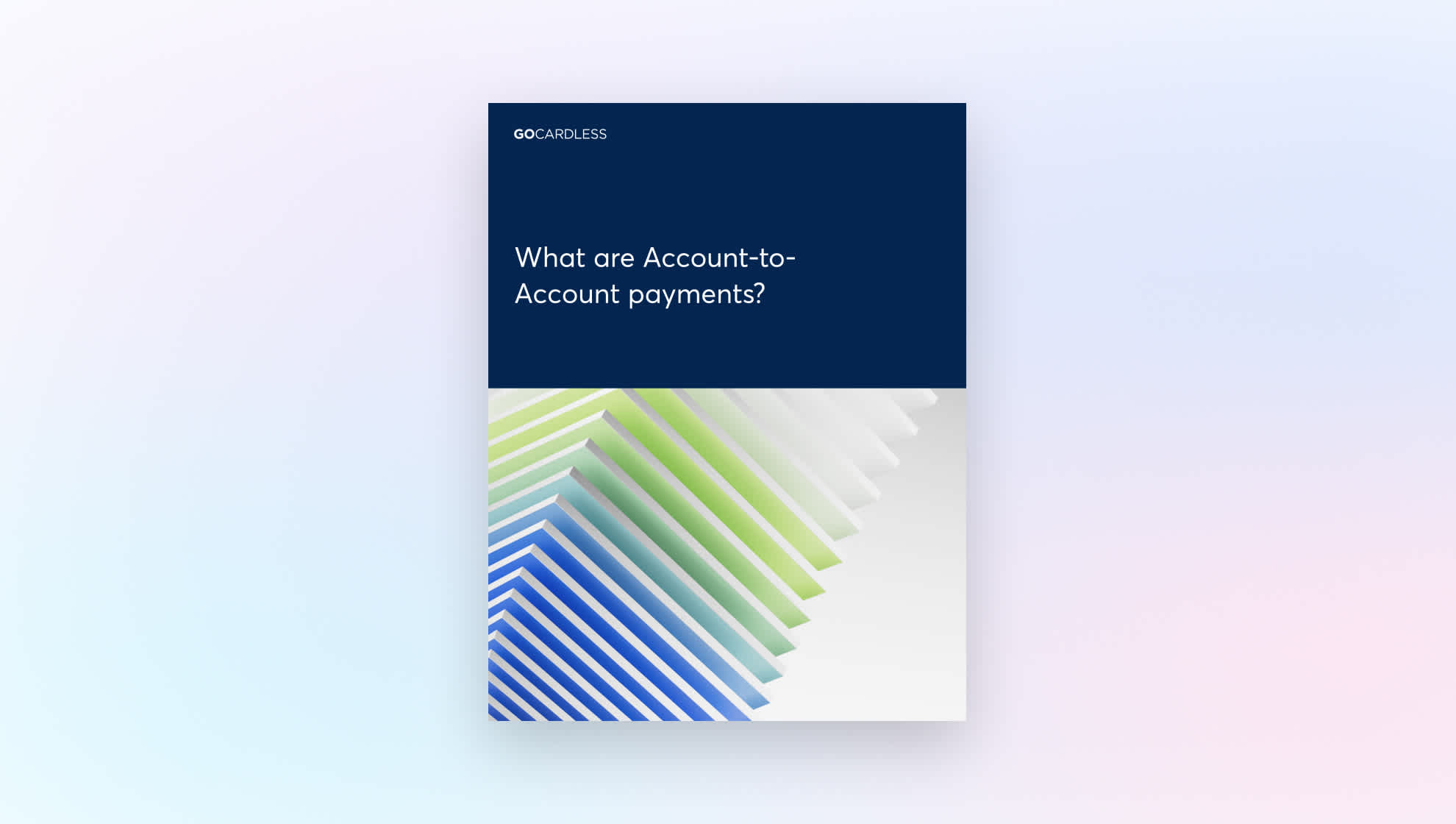
What are Account-to-Account payments?
Last editedJan 20256 min read
What are Account-to-Account payments?
Account-to-Account (A2A) payments move money directly from one account to another without the need for additional intermediaries or payment instruments, such as cards. A2A payments have been around for a while but historically they have been seen as bank account specific payments, for example when a consumer uses a bank transfer or direct debit to pay a bill. However, A2A payments can support all direct account payments, including bank and digital wallets.
Types of A2A payments
There are two types of A2A payments.
Push payments: This payment type is normally used for transferring one-off sums as it requires customers to manually send, or ‘push’, money to you. An example of this would be a bank transfer or instant payment (like GoCardless’ Instant Bank Pay). APIs can also be used to trigger push payments by sending customer notifications or action prompts.
Pull payments: This is when businesses withdraw, or ‘pull’, money from customers' accounts. This payment type is typically used by businesses with recurring payment models, such as subscriptions, and it requires prior consent from the customer. An example of this is a direct debit mandate.
So, why are people talking about A2A payments now and, more importantly, why should you care? Driven by investments in new and existing payment rails, open banking and a shift in consumer behaviour post-COVID-19 pandemic, there has been a recent resurgence in A2A payments, giving them the potential to supersede card payments as consumers’ and businesses’ preferred payment method.
A2A payment rails
Payment rails are the networks that enable the movement of funds from one account to another. In other words, the invisible tracks that power A2A payments. There is no one standardised, global payment rail. Instead, countries are responsible for setting up their own national payment rails.
Over the past 10 years, over 80% of central banks have invested in their payment rails, building new and enhanced networks. Some countries, like Brazil and Australia, have set up a regulatory sandbox to encourage financial institutes to create innovative ideas that could help develop their payment rails.
Why are central banks investing in payment rails?
Competition: We are living in a digital-first society and to be competitive and keep up with emerging technologies and payment expectations, governments must invest in their payment infrastructures
Real-time payments: Without real-time payment options, businesses face going days before noticing failed payments, which can have a range of negative consequences including delayed reconciliation, debt and even increased customer churn.
Reduce fraud: Payment card fraud causes a loss of over $24 billion per year, and that figure is only set to increase unless new, higher security payment options are created
How to collect payments with GoCardless
1.
Create your free GoCardless account, access your user-friendly payments dashboard & connect your accounting software (if you use one).
2.
Easily create payment links to collect one-off or recurring online payments, and share them with your customers.
3.
From now on you'll get paid on time, every time, as GoCardless automatically collects payment on the scheduled Direct Debit collection date. Simple.
Examples of how payment rails have developed around the world
Netherlands
In the Netherlands, the popular online payment system iDEAL is behind 65% of the country’s e-commerce payments. iDEAL has been around since 2005, however, its popularity significantly increased after the introduction of SEPA credit transfers (SCT) in 2019 which allowed real-time payments. iDEAL is expected to hold a market share of 72% by 2022, which isn’t surprising when we know that the adoption of real-time payments in the Netherlands went up by 125% year on year in 2020, with nearly a third of the population also actively using mobile wallets for payments.
Mexico
The payment rail in Mexico is SPEI (Sistema de Pagos Electrónicos Interbancarios) which is owned and operated by Mexico’s central bank, Banco de México. Despite Mexico’s growing young population and 80% of the population being considered urban, there are still a lot of people who are cash reliant - something which is connected to corruption and fraud in the country. Banco de México has worked hard to move people away from cash-only transactions and after years of testing and a pilot, they launched large-scale QR code retail payments. CoDi, short for Plataforma de Cobros Digitales, is a merchant presented QR code that is created by point-of-sale systems, directly linking QR codes to SPEI to utilise its real-time payment functionality. If a consumer does not have an account then they are presented with the option to open a “plain” account that only requires basic information.
Germany
Thanks to Giropay, Germany has been hailed as one of the European markets driving growth. Giropay is based on online interbanking and it enables immediate payments and transfers for those in German markets. Previously, 16% of all online transactions in Germany were processed by Giropay, however, after a recent merger with paydirekt, they are set to increase their market share.
Germany was one of the earliest adopters of SCT, launching real-payment payment capability in 2017. Despite electronic transfers being the most common form of payment, real-time payment popularity has steadily continued to grow. In 2020, real-time payments accounted for 1.8% of 818 million transactions, a figure which is predicted to reach 6.9% by 2025.
Australia
Launched by the Reserve Bank of Australia in 2018, the New Payments Platform (NPP) is Australia's most innovative payment infrastructure. NPP allows for real-time payments between participating Australian banks and enables consumers to transfer funds by linking bank accounts to personal information through its PayID system. NPP’s impact on the payment behaviours has been notable, with customers using the scheme at least once a week and real-time payments up over 130%.
Despite only launching a few years ago, NPP has developed PayTo - previously referred to as Mandated Payments Services (MPS). PayTo enables customers to pre-authorise third parties to initiate payments from their accounts via the NPP.
Open banking and A2A payments
In the past, A2A payments struggled to compete against other payment methods. Manual bank transfers required payers to log into their bank accounts every time they wanted to make a payment and recurring payments often meant a need to complete a long authorisation form - sometimes in paper formats, such as handwritten cheques that were first pioneered by the Bank of England in 1717 or traditional bank debit mandates that started as a paper-based system in 1964. There was also a disjointed user experience when needing to make the first payment, such as when a customer would sign up to a new subscription service and need to make a one-off payment before their bank debit collections begin. Overall, they didn’t offer any substantial benefits over using cards for consumers, and as a result, businesses had to accept high card processing fees and delayed reconciliation times.
However, open banking has helped to breathe new life, and more importantly, new technology, into A2A payments.
What is open banking?
Open banking is the process of banks and other financial institutions opening up data for anyone who consents to access, use and share. The idea behind this modernised banking infrastructure is to increase competition and improve financial services for customers, using data that has been historically kept in-house to create new, innovative products and processes. As a result, businesses and customers can benefit from more efficient financial tools, the ability to automate payments, and greater visibility of their finances.
Each country has their own regulating body that helps to ensure data is safe and used appropriately. For example, in Singapore, open banking is facilitated by the Monetary Authority of Singapore (MAS) and in Australia, it is the Australian Competition and Consumer Commission (ACCC). In the UK, open banking (branded as Open Banking) is guided by the Open Banking Standard (OBS), which is a framework published by the Open Banking Implementation Entity (OBIE), and regulated by the Financial Conduct Authority (FCA).
How open banking has impacted A2A payments
Open banking uses APIs (application programming interfaces) as a way for one piece of software to speak to another. These APIs can connect a bank with third-party providers, enabling the direct movement of money from a payer’s account to a merchant - again, with the payer’s permission. This means that A2A payments can now be made at the point of purchase instead of card payments, offering speed and convenience without excessive data entry or intermediaries adding to the cost of transacting.
Payers also have the opportunity to use digital wallets for everyday transactions, something which is becoming increasingly popular across Europe as it is predicted that payments made via open banking will grow at a CAGR (compound annual growth rate) of 78% per year in the EU.
The benefits of adopting A2A payments
Great customer experience
By combining A2A payments with open banking technology, businesses can now offer their customers a friction-free experience. No intermediaries and no need to add card details multiple times. Instead, APIs have enabled a financial infrastructure that can accept both instant one-off payments and recurring payments from desktop or mobile browsers and apps.
SCA compliant
2021 saw the introduction of Strong Customer Authentication (SCA) - a new European regulatory requirement that is designed to reduce fraud across online transactions over €50. Customers must now prove who they are by demonstrating two of the following three elements:
Knowledge: something the customer knows, such as a pin or password
Possession: something the customer has access to, such as the mobile device that is registered to an account
Inherence: something that the customer is, such as biometric identification
A2A payments that are combined with open banking technology naturally meet the multi-factor authentication requirements and so businesses utilising A2A will be compliant and more likely to see a reduction in fraud and chargeback losses, all without compromising on their checkout experience.
Meet the changing needs of consumers
Consumer preferences are fluid and after the COVID-19 pandemic, there has been an accelerated shift away from traditional payment methods. Instead, consumers are favouring more convenient and time-saving alternatives, with the OBIE revealing that over half of Britons are now using Open Banking-powered apps regularly. Additional research from GoCardless revealed that bank debit is the subscription payment method of choice by consumers in the UK, France and Germany.
Consumers are showing us that yes, they want faster ways to pay, but they also want convenience and security. Card payments have not seen the same advances or innovation as A2A payments, and as a result card payments are becoming outdated and unwanted by consumers. The Bank of America recently found that Gen Z, whose income will account for more than a quarter of the world’s total by 2031, are financially cautious and steer away with payment methods that they believe could lead to debt, such as credit cards.
The future of A2A payments
We’re still only at the beginning of A2A payments’ potential, and its growth won’t be limited to European markets with nine of 10 Gen Z’s living in emerging market nations. Their purchasing power will heavily influence governments who wish to capitalise on this generation’s habits and demands.
Read more about Instant Bank Pay powered by Open Banking via Gocardless.

